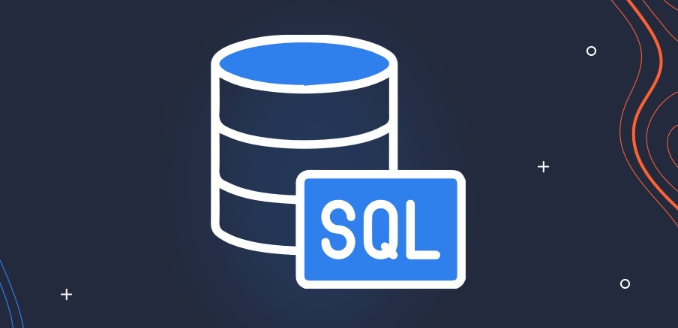When deploying multi-cloud databases, SQL usage is different from traditional environments, and the core is to maintain consistency, compatibility and performance optimization. 1. Different cloud service provider databases have differences in data types, functions, transaction mechanisms, etc., and standard SQL should be used as much as possible and platform features should be encapsulated. 2. Design a general SQL query structure, use ORM or DAL tools to abstract SQL, unify naming specifications and modular scripts to improve maintainability. 3. In terms of performance optimization, it is necessary to analyze the execution plan, avoid complex queries, and monitor slow query logs to deal with efficiency differences between platforms. 4. Data synchronization and distributed query can be implemented through federated queries, ETL tools and database extensions, but attention should be paid to network latency and data consistency issues.

When deploying multi-cloud databases, SQL is used very differently than traditional single-cloud or on-premises environments. The core issue is how to maintain SQL consistency, compatibility and performance optimization between database systems of different cloud service providers.

Multi-cloud database SQL compatibility challenge
Although database services provided by different cloud vendors (such as AWS RDS, Google Cloud SQL, and Azure SQL Database) all support SQL, their implementation details, function syntax, indexing mechanisms, etc. are often different.
- Data types are inconsistent : For example, the JSON type processing method of PostgreSQL on different cloud platforms may be slightly different.
- Specific function limitations : Some built-in functions are only available on a certain platform, for example,
GENERATE_SERIES()is specific to PostgreSQL, but MySQL does not. - Differences in transaction and lock mechanisms : Different cloud platforms may have different default settings for transaction isolation levels and lock waiting time.
Countermeasures:

- Try to use standard SQL to write queries to avoid relying on specific database functions.
- For platform features that must be used, they are packaged into a unified interface to facilitate future migration or adaptation.
How to design a general SQL query structure
In order to maintain SQL maintainability and portability in multiple cloud environments, the abstraction capability of the "SQL layer" needs to be taken into account at the architectural design stage.
- Using intermediate layer ORM or DAL : Abstract SQL into object operations through tools like SQLAlchemy and Prisma, reduce direct dependencies.
- Unified naming specifications : unified style of table names, column names, and index naming, which helps collaborative development across cloud environments.
- Modular SQL scripts : Split common SQL logic into reusable script files or views for easy testing and replacement.
For example, if you have a query that counts user activity, you can write corresponding versions on different clouds, but the call portals are consistent, so that the upper-level application does not need to be changed.

Differences in performance optimization and execution plan
Even with the same SQL statement, execution efficiency may be very different on different cloud platforms. Reasons include:
- Different execution engines : Different database kernel optimizers behave differently, which may cause the same statement to take different execution paths.
- Differences in index policy configuration : Some platforms automatically create indexes, while others require manual intervention.
- Resource scheduling mechanism : The CPU, memory, and IO allocation mechanisms between cloud platforms are different, which affects the query response speed.
Optimization suggestions:
- Regularly analyze execution plans to ensure that queries can run efficiently on all platforms.
- Avoid complex nested queries and use temporary tables or CTEs appropriately to improve readability and optimizeability.
- Monitor slow query logs and promptly discover performance bottlenecks between platforms.
Data synchronization and distributed query skills
In multi-cloud deployment, it is often necessary to extract data from multiple database instances and perform aggregation analysis, which involves cross-database query and data synchronization.
- Using the Federated Query function, such as BigQuery, you can directly query data on AWS S3.
- Regularly synchronize critical data to a unified data warehouse with the help of ETL tools.
- If using PostgreSQL, consider using the
postgres_fdwextension to access the remote database.
Although these methods can solve the problem, they need to pay attention to challenges in network latency, data consistency, and permission management.
Basically that's it. When using SQL in a multi-cloud environment, the key is to plan compatibility and scalability in advance. Don’t wait until it is launched to find that a statement cannot run on a platform.
The above is the detailed content of SQL for Multi-Cloud Database Deployments. For more information, please follow other related articles on the PHP Chinese website!

Hot AI Tools

Undress AI Tool
Undress images for free

Undresser.AI Undress
AI-powered app for creating realistic nude photos

AI Clothes Remover
Online AI tool for removing clothes from photos.

Clothoff.io
AI clothes remover

Video Face Swap
Swap faces in any video effortlessly with our completely free AI face swap tool!

Hot Article

Hot Tools

Notepad++7.3.1
Easy-to-use and free code editor

SublimeText3 Chinese version
Chinese version, very easy to use

Zend Studio 13.0.1
Powerful PHP integrated development environment

Dreamweaver CS6
Visual web development tools

SublimeText3 Mac version
God-level code editing software (SublimeText3)
 Defining Database Schemas with SQL CREATE TABLE Statements
Jul 05, 2025 am 01:55 AM
Defining Database Schemas with SQL CREATE TABLE Statements
Jul 05, 2025 am 01:55 AM
In database design, use the CREATETABLE statement to define table structures and constraints to ensure data integrity. 1. Each table needs to specify the field, data type and primary key, such as user_idINTPRIMARYKEY; 2. Add NOTNULL, UNIQUE, DEFAULT and other constraints to improve data consistency, such as emailVARCHAR(255)NOTNULLUNIQUE; 3. Use FOREIGNKEY to establish the relationship between tables, such as orders table references the primary key of the users table through user_id.
 Key Differences Between SQL Functions and Stored Procedures.
Jul 05, 2025 am 01:38 AM
Key Differences Between SQL Functions and Stored Procedures.
Jul 05, 2025 am 01:38 AM
SQLfunctionsandstoredproceduresdifferinpurpose,returnbehavior,callingcontext,andsecurity.1.Functionsreturnasinglevalueortableandareusedforcomputationswithinqueries,whileproceduresperformcomplexoperationsanddatamodifications.2.Functionsmustreturnavalu
 Using SQL LAG and LEAD functions for time-series analysis.
Jul 05, 2025 am 01:34 AM
Using SQL LAG and LEAD functions for time-series analysis.
Jul 05, 2025 am 01:34 AM
LAG and LEAD in SQL are window functions used to compare the current row with the previous row data. 1. LAG (column, offset, default) is used to obtain the data of the offset line before the current line. The default value is 1. If there is no previous line, the default is returned; 2. LEAD (column, offset, default) is used to obtain the subsequent line. They are often used in time series analysis, such as calculating sales changes, user behavior intervals, etc. For example, obtain the sales of the previous day through LAG (sales, 1, 0) and calculate the difference and growth rate; obtain the next visit time through LEAD (visit_date) and calculate the number of days between them in combination with DATEDIFF;
 How to find columns with a specific name in a SQL database?
Jul 07, 2025 am 02:08 AM
How to find columns with a specific name in a SQL database?
Jul 07, 2025 am 02:08 AM
To find columns with specific names in SQL databases, it can be achieved through system information schema or the database comes with its own metadata table. 1. Use INFORMATION_SCHEMA.COLUMNS query is suitable for most SQL databases, such as MySQL, PostgreSQL and SQLServer, and matches through SELECTTABLE_NAME, COLUMN_NAME and combined with WHERECOLUMN_NAMELIKE or =; 2. Specific databases can query system tables or views, such as SQLServer uses sys.columns to combine sys.tables for JOIN query, PostgreSQL can be used through inf
 How to create a user and grant permissions in SQL
Jul 05, 2025 am 01:51 AM
How to create a user and grant permissions in SQL
Jul 05, 2025 am 01:51 AM
Create a user using the CREATEUSER command, for example, MySQL: CREATEUSER'new_user'@'host'IDENTIFIEDBY'password'; PostgreSQL: CREATEUSERnew_userWITHPASSWORD'password'; 2. Grant permission to use the GRANT command, such as GRANTSELECTONdatabase_name.TO'new_user'@'host'; 3. Revoke permission to use the REVOKE command, such as REVOKEDELETEONdatabase_name.FROM'new_user
 What is the SQL LIKE Operator and How Do I Use It Effectively?
Jul 05, 2025 am 01:18 AM
What is the SQL LIKE Operator and How Do I Use It Effectively?
Jul 05, 2025 am 01:18 AM
TheSQLLIKEoperatorisusedforpatternmatchinginSQLqueries,allowingsearchesforspecifiedpatternsincolumns.Ituseswildcardslike'%'forzeroormorecharactersand'_'forasinglecharacter.Here'showtouseiteffectively:1)UseLIKEwithwildcardstofindpatterns,e.g.,'J%'forn
 How to backup and restore a SQL database
Jul 06, 2025 am 01:04 AM
How to backup and restore a SQL database
Jul 06, 2025 am 01:04 AM
Backing up and restoring SQL databases is a key operation to prevent data loss and system failure. 1. Use SSMS to visually back up the database, select complete and differential backup types and set a secure path; 2. Use T-SQL commands to achieve flexible backups, supporting automation and remote execution; 3. Recovering the database can be completed through SSMS or RESTOREDATABASE commands, and use WITHREPLACE and SINGLE_USER modes if necessary; 4. Pay attention to permission configuration, path access, avoid overwriting the production environment and verifying backup integrity. Mastering these methods can effectively ensure data security and business continuity.
 When to use SQL subqueries versus joins for data retrieval.
Jul 14, 2025 am 02:29 AM
When to use SQL subqueries versus joins for data retrieval.
Jul 14, 2025 am 02:29 AM
Whether to use subqueries or connections depends on the specific scenario. 1. When it is necessary to filter data in advance, subqueries are more effective, such as finding today's order customers; 2. When merging large-scale data sets, the connection efficiency is higher, such as obtaining customers and their recent orders; 3. When writing highly readable logic, the subqueries structure is clearer, such as finding hot-selling products; 4. When performing updates or deleting operations that depend on related data, subqueries are the preferred solution, such as deleting users that have not been logged in for a long time.






